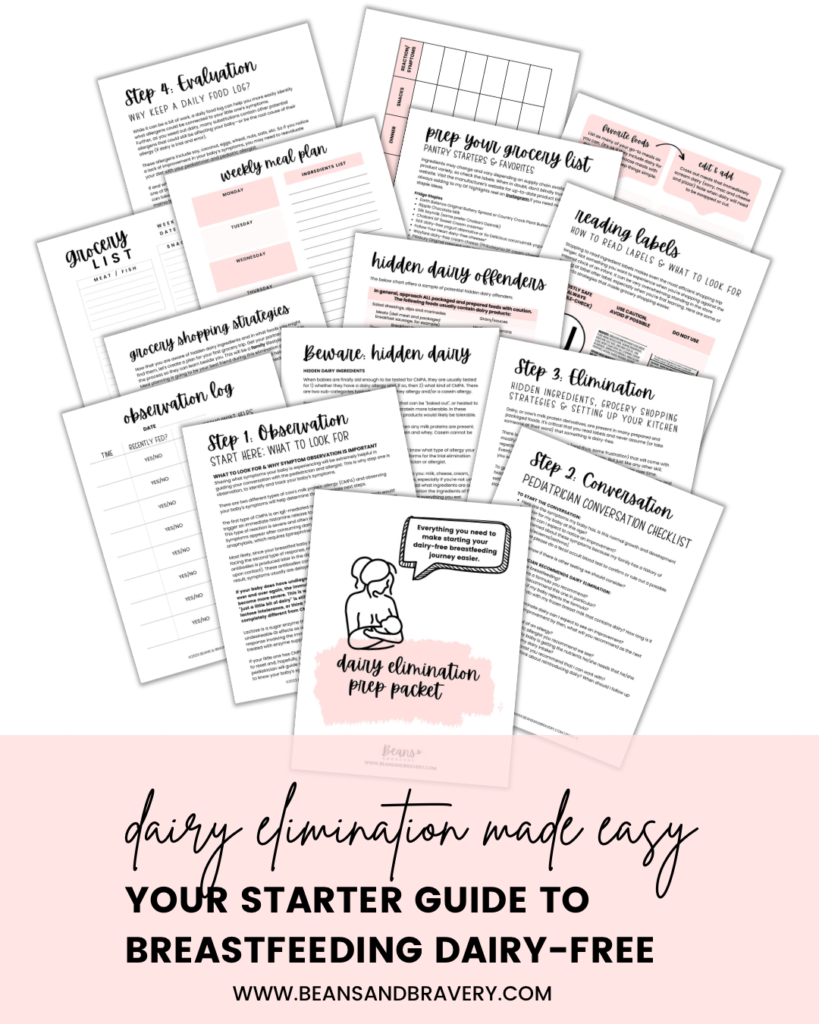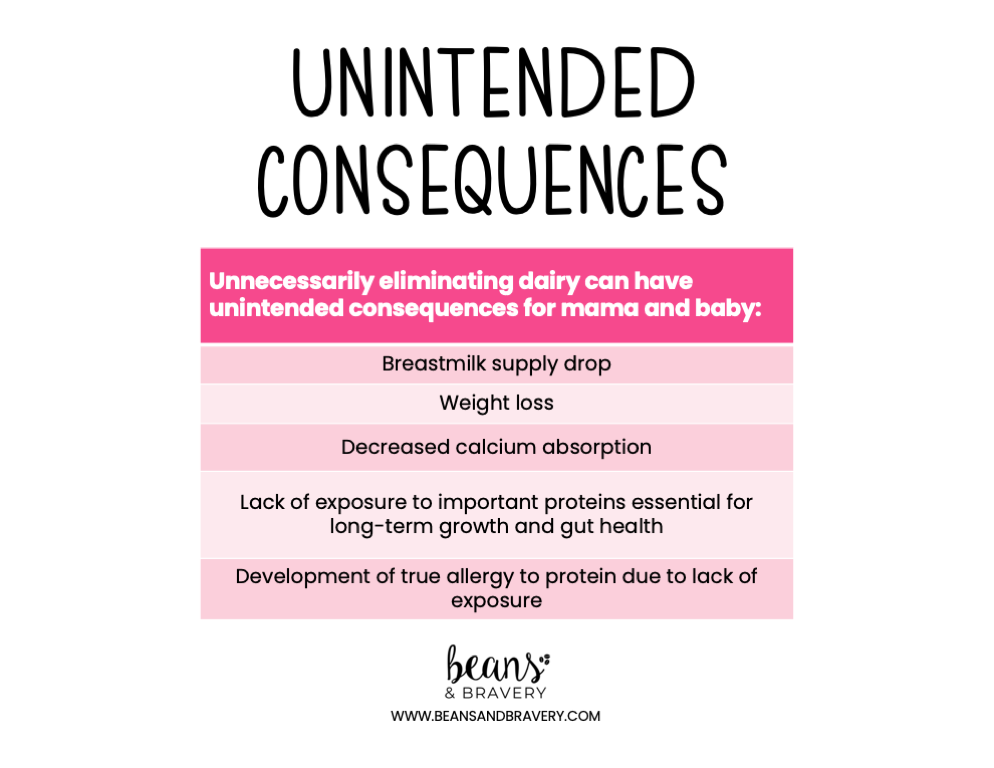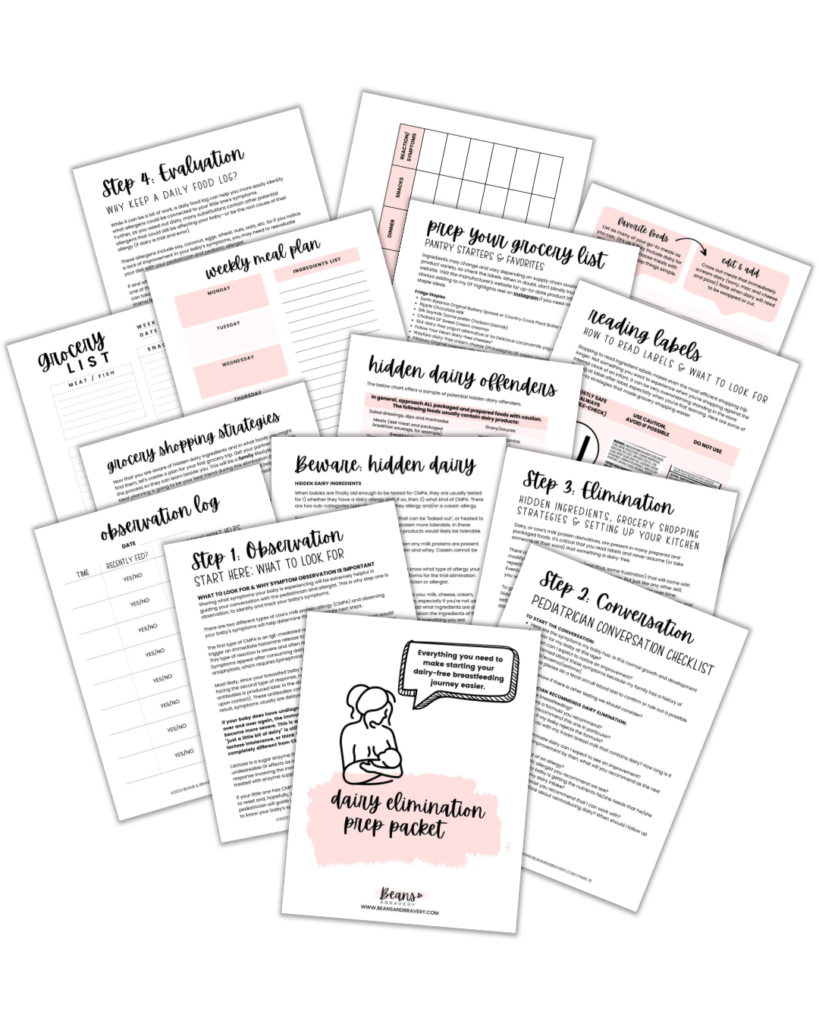Hi mama! If you think your newborn has a dairy allergy and you’re contemplating dairy elimination while breastfeeding, keep reading. I’ve noticed more and more moms choosing to eliminate dairy from their diets to help calm their newborns’ fussy symptoms. (I, too, am one of those mamas.) I learned so much during our dairy elimination journey. Here’s everything I’ve learned to hopefully save you hours of research.
Dairy elimination while breastfeeding is a common solution mamas are testing. But did you know dairy elimination isn’t necessary for all who make the choice? In some cases, unnecessary dairy elimination can even do more harm than good long-term.
This article will offer research-based guidance to help you have a conversation with your pediatrician about whether dairy elimination is right for you and your baby. I’ve created a FREE “DAIRY ELIMINATION PREP PACKET” that includes a checklist for your conversation with the pediatrician, a symptom tracker, a dairy-free pantry starter list, and more.

First, there are several reasons your baby could be acting like a gigantic fusspot. Though a quick search and Dr. Google might lead you to believe dairy is the issue and dairy elimination is the solution. All you know is that your baby looks uncomfortable, is extremely irritable, and NOTHING IS WORKING to console her.
I remember crying because my little ones were inconsolable. Hearing them cry like that just ripped my heart out. It is so easy during this frustrating period of their newborn life to want to regain some sort of control.
But is dairy elimination the solution? Before you choose to eliminate dairy, here are some factors for you to evaluate.
Is dairy elimination while breastfeeding completely necessary?
How old is your baby?
Why is age relevant? Around the time dairy allergies typically build up and manifest, your baby also is going through other changes. Babies between 3 weeks and 3 months old go from blissfully sleeping little dears to giant inconsolable fusspots all of a sudden. And just like that comes a new parenting curveball!
Babies around this age typically experience normal GI tract growth, and another milestone known as “the witching hour,” which can cause excessive fussiness. Additionally, colic (excessive crying of 3+ hours in an otherwise healthy baby) can appear around this time. These different factors can make it difficult to separate symptoms to pinpoint exactly what is wrong. But before you consider dairy elimination, consider whether your little one falls into this age range and whether your baby could be experiencing these very normal (though frustrating) milestones.
Is your baby getting fussy at a particular time of day?
Next, it’s time to determine whether your baby is getting fussy at a particular time of day. Use the chart included in the FREE DAIRY ELIMINATION PREP PACKET below to track your baby’s fussiness and symptoms over the course of one week. If your baby isn’t exhibiting many specific dairy allergy symptoms, notice whether your baby is getting fussy at a particular time of day. Is your baby overtired? Pay close attention to sleepy cues. Your baby could need a nap or even an earlier bedtime.
Is your baby overstimulated?
Does your chart reveal a pattern of extreme fussiness occurring toward the late afternoon/evening hours? Your baby could be experiencing the “witching hour,” or be overstimulated. This most often occurs during a particularly busy time of day (it happens typically around dinner time when everyone is arriving home, trying to do homework, trying to get dinner, etc.). Put simply, it’s the byproduct of a long, busy day of your infant taking in his or her surroundings. For your little one, this should be the winding-down time where lights are low, noises are softer and your baby can prepare for bedtime.
During this growth period, your baby also could be fussy out of frustration because low milk supply is common in evening hours. This is totally normal in nearly all nursing mamas. In either case, these reasons are completely normal and part of your little one’s growth and development.
Pay attention to the symptoms
If you’re considering dairy elimination while breastfeeding, chances are your baby is exhibiting one or many of the following symptoms:
*If your baby is exhibiting any of these symptoms, call your pediatrician immediately.
Related Post: What You Must Know about Dairy Elimination While Breastfeeding
Some symptoms are completely normal GI tract growth symptoms. In these cases, your little one’s body is working hard to develop his or her healthy gut bacteria and getting used to the proteins. You can read more about infant gut growth and development here. But to summarize briefly, a growing digestive tract needs to learn to adapt to a mother’s milk or choice of formula. The current theory is that no live bacterial communities are present in a baby’s gut in utero. Instead, an infant’s gut microbiota starts to evolve after birth through breastmilk (or formula) exposure, and continues to develop through the transition to food. The good news is most symptoms your baby has because of a normally developing GI tract shouldn’t last too long.
Other, more alarming, symptoms can be indicators of a dairy (or other protein) allergy. A true dairy allergy (called Milk Protein Allergy or MPA, the most common being Cow’s Milk Protein Allergy or CMPA) is diagnosable.

Does my baby have an allergy?
And if so, which type?
It is worth noting that lactose intolerance and CMPA are not the same thing. You can read more about the difference here. But to summarize, CMPA is an immune response that is potentially life-threatening. Whereas lactose intolerance does not involve the immune system at all. Instead, it is related to a missing enzyme that impacts digestion and causes discomfort, but is not life-threatening.
Initial efforts to diagnose infant dairy allergies are often based on family history, and trial and observation because doctors will usually advise against aggressive testing on infants. Your pediatrician will likely take a thorough family history of allergies, eczema, and asthma.
A non-invasive fecal occult blood stool test (done on your baby’s poopy diaper) will test for traces of blood, which is an indicator of cow-milk or soy protein-induced allergic colitis. If it’s positive for blood, dairy elimination will typically be recommended first, then soy if symptoms don’t resolve with dairy elimination.
When your infant is older, CMPA is confirmed through skin tests, blood tests, and food challenges. These will be important when it’s time to reintroduce dairy into your little one’s diet. Experts agree that CMPA infants should be tested every 6-12 months to identify whether the allergy still exists. Most babies will grow out of CMPA by age 6.
Then, there are two different types of CMPA. The first is an IgE-mediated response (hypersensitivity), which would trigger an immediate histamine release to produce an immediate allergic reaction. The second is a non-IgE-mediated CMPA, which essentially means a build-up of antibodies are produced later in the digestion process (rather than immediately upon contact). These antibodies contribute to an inflammatory cascade. As a result, symptoms usually are delayed.

If your baby is showing symptoms aligned with CMPA, it is important to contact your pediatrician. The more specific you are about the symptoms, the better.
Non–IgE-mediated allergy is certain with isolated blood-streaked poop. Whereas, IgE-mediated CMPA is more closely linked with multiple allergies, atopic conditions, and potentially asthma development later in life.
Read more about IgE-mediated and non-IgE-mediated CMPA here.
Consequences of unnecessary dairy elimination while breastfeeding
Our pediatric allergist, backed by several studies I referenced throughout writing this article, pointed out one very important piece of information that is missing alongside well-intentioned recommendations to try dairy elimination. That is: Unnecessary dairy elimination while you are breastfeeding is capable of doing more harm than good. This is the case for both you and your baby.
Babies who do not have CMPA and who aren’t exposed to milk protein during their crucial GI development phase are at an increased risk of permanent allergies. Additionally, mamas embarking on dairy elimination diets while breastfeeding should consult a nutritionist to help maintain a balanced and nutritious diet, and avoid calcium deficiency, significant weight loss, and breastmilk supply drops.

How do I know if cutting dairy is the right thing to do?
Only you and your pediatrician can decide what is best for you and your baby. If your baby has CMPA, or your pediatrician suspects it’s the cause of your baby’s symptoms, they’ll likely recommend cutting dairy. This will mean strict elimination of ALL dairy products, not just milk. With dairy allergies, there is no such thing as a cheat day.
Is it still safe to breastfeed my baby?
In most cases, yes. Breastfeeding will still be the recommended feeding method. But please consult your pediatrician. It can take up to six weeks for CMPA to clear both your and your baby’s systems and for symptoms to resolve. Don’t be alarmed if you don’t notice results immediately.
As I mentioned, babies are most often diagnosed with suspected CMPA through family history and fecal occult blood tests. FOBT determine an allergy is present, but do not indicate which type of allergy (milk or soy).
So, if you are considering switching to formula because you are unable or unwilling to do dairy elimination, then discuss with your pediatrician appropriate formula substitutions. In addition to soy being a potential allergen for your baby (if CMPA is a theory, but not confirmed), a number of sources I consulted when writing this article recommended avoiding soy-based formula for infants under 6 months.
Several studies such as this one from CHOP have identified potential estrogen-influencing compounds in soy-based formula that, when used long-term, can affect the endocrine system and potentially interfere with normal hormonal development.
I’m eliminating dairy … how do I still breastfeed?
Reading ingredient labels will be important to avoid hidden dairy ingredients such as whey, lactose, casein, buttermilk, lactose, yogurt, sour cream, cheese, cream, curds, and more. Kelly Mom offers this great hidden dairy cheat sheet. Dairy ingredients should be clearly called out as one of the eight major allergens. One easy way to identify a dairy-free product is kosher labeling. A product label marked with a circled “U” (no other letter or symbol) is parve, or certified dairy-free.
While restaurants are getting better at accommodating allergies, it’s risky to trust foods prepared by others. You can ask all the right questions, but staff sometimes don’t care or don’t know about the ingredients used in foods or preparation methods. It’s a serious challenge to order in when everything from chicken marinades to salad dressings, to bakery rolls, hamburger buns, prepared veggies and desserts contain dairy.
I eliminated dairy so that I could continue breastfeeding. Perhaps one of the biggest challenges of going dairy-free is needing to think about the steps that go into “fast” and prepared foods. Are the chicken nuggets you’re craving breaded? If so, the chicken is likely dredged in milk. Is the grilled chicken marinated in Italian dressing? Parmesan cheese is a common ingredient. Is the hamburger roll served on a brioche bun? All of these items contain milk or dairy, which will trigger symptoms in a CMPA baby. For these reasons, I’ve found preparing my own food to be the safest option.
Another thing to consider is what ingredients are in your dairy substitutes. If you notice your baby is getting worse with dairy elimination, soy and eggs are the next common protein allergens for babies. Soy is in a ridiculous number of foods (literally everything packaged), especially in plant-based dairy substitutes. Try not to eliminate all allergens at once. Not only is it extremely difficult and limiting for your diet, but then it will be difficult to pinpoint the allergen.
Dairy-free pantry options
Trying to prepare your own food 100% of the time is impractical and impossible with an infant. So here are some of my favorite dairy-free kitchen staples to make your life easier. Always check the ingredients in case of changes. (I share these products through my affiliate links and I may receive a small commission if you choose to make a purchase, at no extra cost to you.) A complete list is in my Dairy Elimination Prep Packet. Download it below!
Dairy Elimination Prep Packet

For further research
CHOP Study: Soy-Based Infant Formula
Milk allergy versus lactose intolerance
Approach to Milk Protein Allergy in infants (study)
Prevention of Allergic Sensitization and Treatment of Cow’s Milk Protein Allergy in Early Life (study) Cow’s milk protein allergy in children: a practical guide (study)
Good luck on your dairy elimination journey, mama!

P.S. Was this post helpful? Please share it! You can check out my other posts here. And follow me on Instagram here.



2 comments